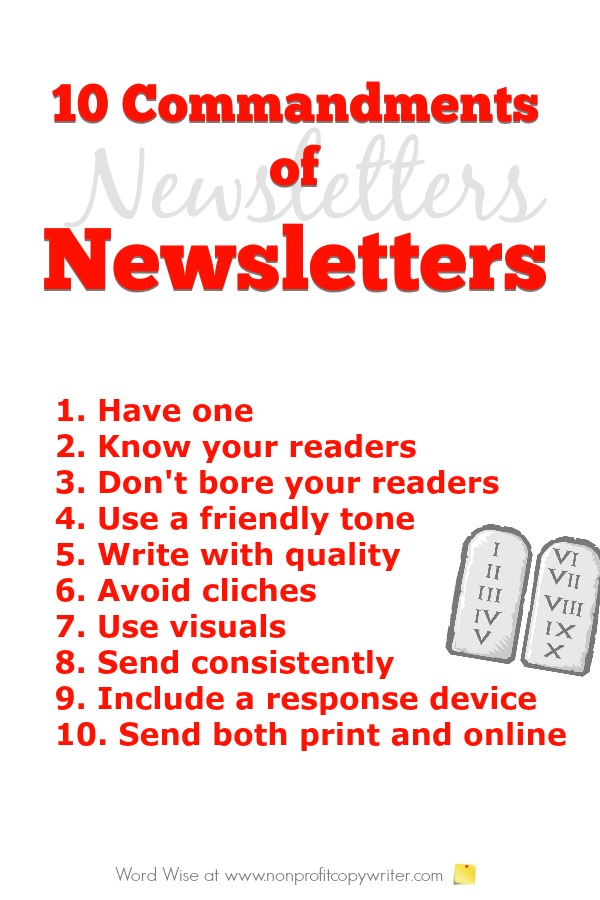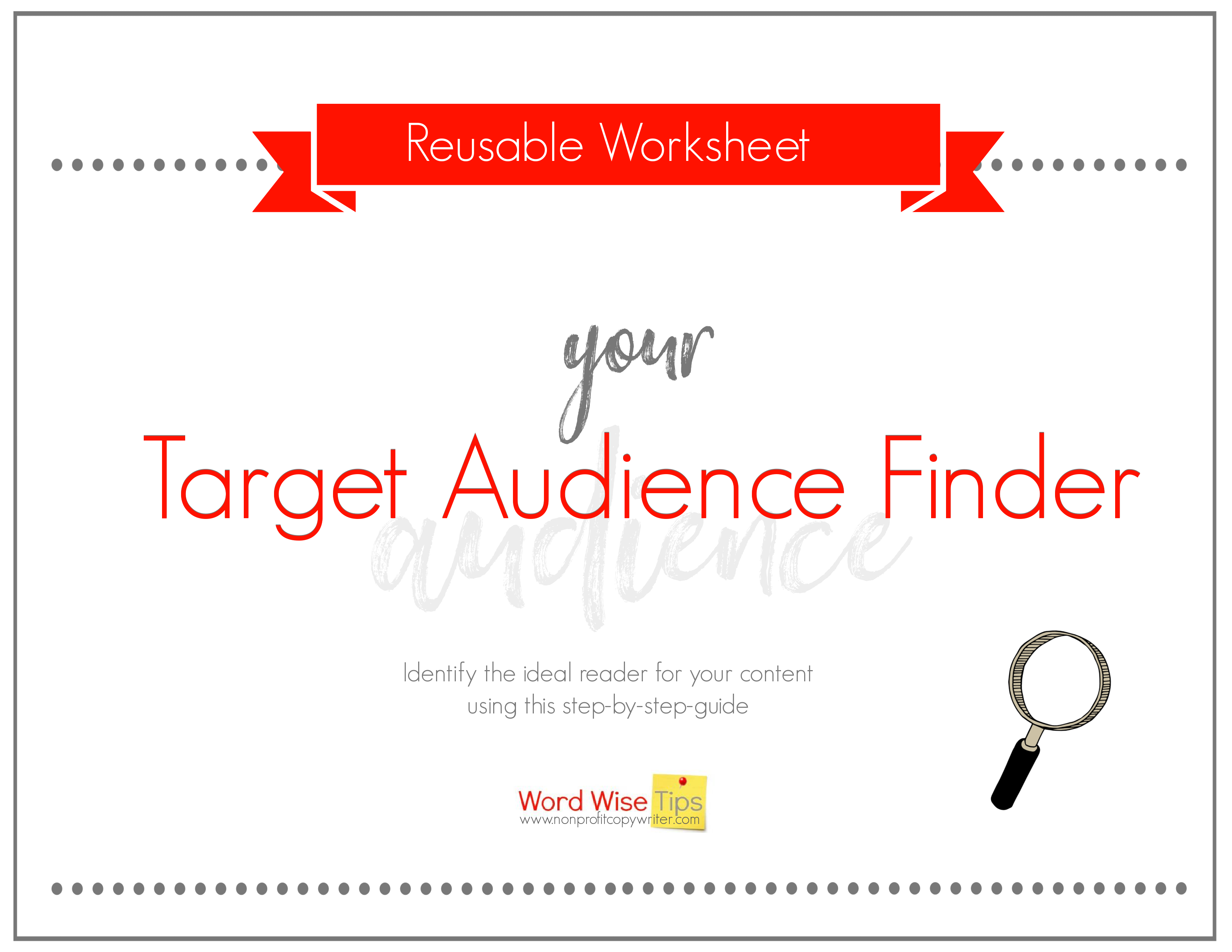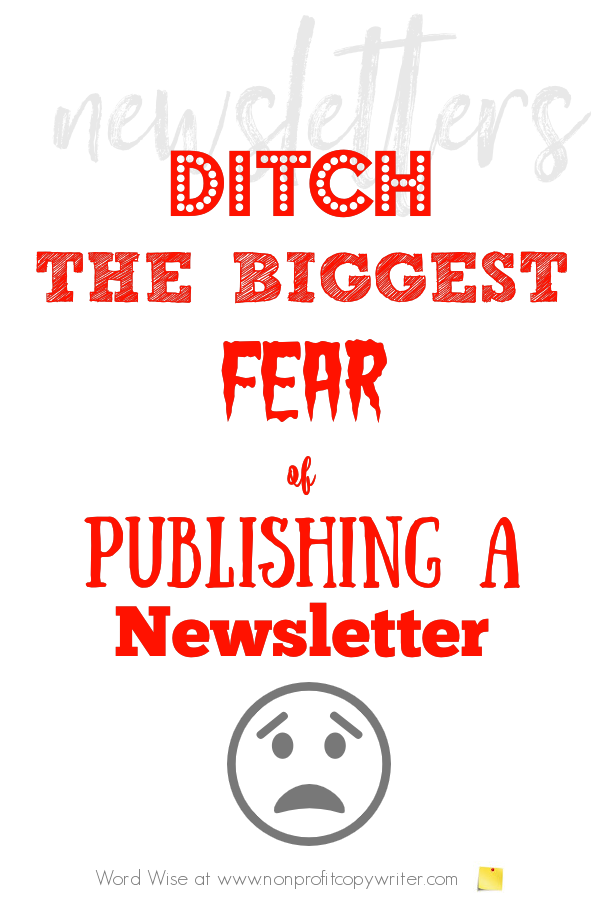
10 Commandments of Nonprofit Newsletters
Award-winning writer Kathy Widenhouse has helped hundreds of nonprofits and writers produce successful content and has gained 600K+ views for her writing tutorials. She is the author of 9 books. See more of Kathy’s content here.
Updated 8.15.24
Nonprofit newsletters are a powerful tool to use to keep you in touch with your donors and prospects.
In fact, no matter what your industry – from media to publishing to tech startups to services to retail – you can get in front of readers regularly with a newsletter. Especially if you publish one online.
This is especially true for small businesses and solopreneurs.
I know this from firsthand experience. I built my writing business by starting a newsletter and sending it first monthly and now weekly. My newsletter is not simply proven way to extend my reach to build a following. I’d argue it’s been the best way online for me to cultivate the readers I already have and help them become true fans.
All that newsletter goodness means there’s plenty of people with newsletter experience. And to be honest, I find all the detailed “newsletter rules” intimidating. And this even after I’ve successfully published newsletters for a couple of decades.
Don’t let that deter you. . I like to keep things simple. If you’d like to publish a newsletter – or re-start a lapsed one – then you can do so, even if you’re not a pro marketer or tech expert. Just follow these 10 newsletter commandments. They work.
10 Commandments of Newsletters
1. Thou shalt have one
These days, it’s not hard to miss the value of publishing nonprofit newsletters – or newsletters for any biz or solo operation, for that matter. Particularly since email makes sending newsletters so simple (with templates) and affordable (some providers like Mail Chimp and Constant Contact even offer a free trial).
64% of small businesses use email marketing to reach customers – and more than half (57%) report that they are planning to increase their spending on email newsletters.
A newsletter is a primary means of communicating with your readers. Make sure you’re among the majority who publishes one. Otherwise, you’re leaving money on the table.
Plus, over time, newsletters provide a way to document your organization’s history.
2. Thou shalt know thy reader
These are people who already have shown their interest in you, whether by opting in, signing up for your communications or making a purchase or donating to your cause. They make up your “house list.”
They’re invested in you. Naturally, you want to keep them in the loop. Understand their hot buttons and why they have partnered with you in the first place. Speak to those issues.
3. Thou shalt not bore your readers
A client wanted the lead newsletter story to be about his nonprofit’s new software. (Can you say “B-O-R-I-N-G”?) I explained, as gently as I could, that “most of your readers don’t care very much about what computer package you use.” Instead, I said, they want to read about the young boy who now has three meals a day because of their programming.
Provide fascinating content and newsworthy updates, not tedious in-house strategy summaries. Include engaging stories about your beneficiaries, how-to’s, event information, data, profiles, and anecdotes about those you serve. Make sure your content has substance that supports your mission. Ads and promotion are secondary. Strive for the 80-20 rule in your content: 80% inspiring or helpful information and 20% or less in promotion.
Identify the ideal reader for your content with this fillable worksheet.
4. Thou shalt use the right tone
Newsletters are a means to keep partners and prospects up to date about what’s going on in the family. They’re not a soap box. The tone is always reader-centered, designed to inspire and motivate. No scolding, preaching, threatening, begging, or posturing allowed.
Instead of lecturing, use a conversational voice – one from the friendly neighbor. Imagine you’re sitting with a friend – your reader – and jabbering about all the good stuff you’ve done and learned. Then read your content aloud. If it doesn’t sound like a chit-chat with your grandma, then rewrite it.
(Get tips here for writing conversationally.)
5. Thou shalt honor the Law of Quality
An eye-catching layout and a professional presentation show the reader you are not a fly by night operation, but credible. Plus, today’s email marketing tools (like Constant Contact) make easy for the most tech-challenged publisher to put out a quality online newsletter. Simply choose a template, load your logo and content, preview it, and click “Send.”
But the Law of Quality extends beyond mere packaging. Just as important is your content, particularly if you want readers to click “Open” when you send them the next issue – and the next. Include insights, tips, case studies, or other valuable content that positions the sender as knowledgeable and trustworthy.
By consistently delivering valuable content, newsletters help build brand awareness and loyalty. They keep subscribers informed about the organization's activities, values, and offerings, fostering a stronger connection. Demonstrate consistent quality and your newsletter can showcase expertise and thought leadership within your niche.
Excellence is so crucial that it’s worth financial layout. If you don’t have time or staff to put together a high-quality publication, then outsource it.
6. Thou shalt use plain language
Let’s say you’re an organization that provides support for families of diabetics. You may feel the urge to delve deeply into the chemical structure of dipeptidyl peptidase-4 inhibitors. But your readers simply want to know that DPP-4s help reduce blood sugar levels. And they are eager for tips about how to manage that class of meds for their loved one.
Keep verbiage to a minimum and write clearly. Most word processing programs include a readability tool, like Flesch Reading Ease and Flesch-Kincaid Grade Level tools to assess your content’s readability. Aim for a 6th-8th grade reading level.
In the same way, use all the tools at your disposal to write simply and clearly. Vary sentence length. Where possible, use lists, bullets, and lots of white space.
7. Thou shalt use attractive visuals
Photos, action shots, graphs, charts, color and easy-to-read fonts make your newsletter user- friendly.
You don’t need to be a designer to include them. Nor must you pay a fortune to generate your own. Thanks to user-friendly tools like Canva and PicMonkey, non-artistic types like me can create top-notch visuals to help tell the story of your biz or organization.
The best place to find images for your newsletter? You. Take in-house images of the people you serve or the work that you do. (Note: be sure to obtain a signed release for publication. And respect the privacy of children and the vulnerable.)
8. Thou shalt stick to a mailing schedule
Choose to communicate consistently. Schedule your newsletter at regular intervals (weekly, monthly) to provide a predictable way to keep subscribers informed about your news, updates, events, or developments.
By sending at regularly intervals – say, every Wednesday afternoon – you earn your reader’s respect. They learn they can rely on you. But haphazard sends don’t soothe readers. In fact, in a world of unpredictability, your publication becomes just another part of the chaos.
A consistent schedule is an advantage for you, too. When you publish regularly, you’re “forced” to produce consistent, valuable content for your readers. And as you upload all that yummy, SEO-optimized information to your online home, you build your reach.
9. Thou shalt include a response device
Provide a response device in every newsletter, whether it’s a buck slip in a print newsletter or a Donate link in your enews. Give your reader a chance to interact with you, offering him opportunities to give, pray, volunteer, engage through social media, or otherwise participate. (Extra tip: a separate buck slip and return envelope will net better response than a tear-out coupon in a print newsletter.)
10. Thou shalt offer thy newsletter online
Your newsletter can be print or electronic – or both. Clearly, email newsletters are cheaper to produce. There’s no printing or postage costs while reaching a potentially larger audience. According to Campaign Monitor, email marketing (which includes newsletters) has an average ROI of 4200%, making it a highly effective channel for engagement and retention.
So if you have to choose between print and email newsletters, send yours by email. Email newsletters are cheaper to produce than print ones. If you have readers on your house list that don’t want email, then you can format a simple print copy from your email version, print it, and pop it in the mail. And you can archive back issues on your website as an informational resource.
Better yet if you can afford it: send both. Use the content form your print newsletter to create 2 or 3 successive short email newsletters to send in succession. You’ll reinforce the principle of repetition.
Face the biggest fear of publishing nonprofit newsletters
If you do nothing else, follow Commandment #1 for nonprofit newsletters: have one.
Face down your fear of not being perfect. It’s okay if you make mistakes in your first few issues. In fact, I guarantee that you will. The first few issues may take more time than you thought you’d have to invest and you’ll find you’re overwhelmed by your blunders.
Don’t let that deter you. Your readers need to hear from you. The more you send a newsletter, the faster you’ll get at preparing an issue for publication – and the better your content will be. Just get going and get publishing.
More Writing Tips for Newsletters
How to Start a Newsletter in Just 3 Steps ...
5 Reasons You Should Create an Email Newsletter ...
Publishing a Newsletter? Use This Top Writing Tip for Success ...
7 Tips for Writing Winning Newsletters ...
Three types of newsletters: which is right for you?
Include these 5 different types of articles in your newsletter ...
Use a Lead Magnet to Get Content Writing Leads and Prospects ...
29 kinds of newsletter articles you can write ...
Top newsletter article tips: how to make sure your articles get read ...
How to repurpose your newsletter into 21 (or more) pieces of content ...
What's a listicle and how do I write one that sticks?
Images for newsletters: use real photos (when you can) ...
Top tip on writing a newsletter: feature a heartfelt feature story ...
Freebie: Quozio lets you create graphics in 5 minutes or less ...
What are ezines and do I need to publish one?
Your nonprofit ezine: why should readers subscribe?
What to write in your welcome email to new subscribers ...
How nonprofit ezines build exposure ...
Nonprofit social media tutorial for newbies ...
More newsletter writing tips on our Pinterest board ...
Return from 10 Commandments for Nonprofit Newsletters to Nonprofit Copywriter home
As an Amazon Associate I earn from qualifying purchases.
Search This Site
Share This Page

Named to 2022 Writer's Digest list
BEST GENRE/NICHE WRITING WEBSITE


Stop Wasting Time!

Grab your exclusive FREE guide, "5 Simple Writing Tips You Can Put to Use in 10 Minutes or Less"











